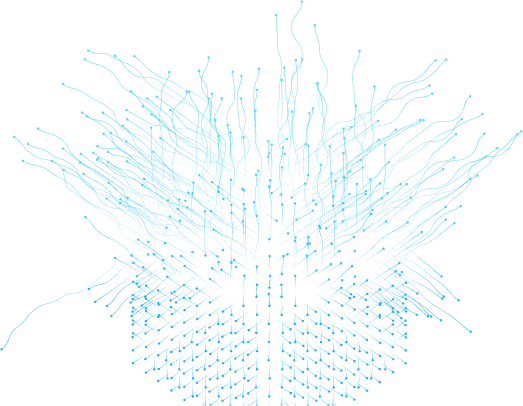
Building Blocks of Empowered Blockchain Scalability Solutions
Table of Contents
Introduction
In the realm of blockchain technology, scalability stands as a pivotal challenge on the path to widespread adoption. While the potential for decentralized, secure, and transparent systems is clear, accommodating a growing number of transactions without compromising performance or security is imperative. As blockchain networks expand and user demands increase, the need for innovative scalability solutions becomes more pronounced.
This exploration takes you through the unique and structured building blocks that empower blockchain scalability solutions. We will delve into the foundational elements that pave the way for enhanced transaction throughput, improved performance, and the seamless growth of blockchain networks. By understanding these building blocks we can unlock the true potential of block technology, foster its widespread adaptations and solve blockchain scalability problems.
The Pillars of Scalable Blockchain Networks
Consensus mechanisms serve as the foundational pillars of scalability meaning in the blockchain. These mechanisms play a crucial role in ensuring the purity and security of the distributed ledger.
In a blockchain network, multiple participants, or nodes, sustain a copy of the ledger and validate transactions. Consensus mechanisms enable these nodes to agree on the state of the blockchain and reach a consensus on which transactions are considered valid and should be added to the blockchain.
There are several consensus mechanisms, each with its approach to achieving agreement. Here are some commonly used consensus mechanisms:
Proof-of-Work (PoW)
PoW has been the traditional consensus mechanism used in blockchain networks, most notably in Bitcoin. It relies on miners competing to solve computationally intensive puzzles to validate transactions and add blocks to the blockchain. While PoW has proven to be secure and resilient, it poses a scalability issue in blockchain.
Proof-of-Stake (PoS)
PoS is an alternative consensus mechanism that aims to address the energy consumption and blockchain scalability issues associated with PoW. In PoS, validators are chosen to create new blocks and validate transactions based on the amount of cryptocurrency they hold and “stake” in the network.
One prominent example is Proof-of-Stake (PoS), where block validators are chosen based on their stake in the network. PoS significantly reduces energy consumption by eliminating the need for resource-intensive mining. It enables higher transaction throughput and faster block confirmation times, improving blockchain privacy and scalability.
Delegated Proof-of-Stake (DPoS)
DPoS builds upon the PoS concept and introduces a system of elected delegates who validate transactions on behalf of the network participants. Instead of every participant competing to create blocks, a smaller group of elected representatives takes on this responsibility.
Practical Byzantine Fault Tolerance (PBFT)
Practical Byzantine Fault Tolerance (PBFT) is a consensus mechanism commonly employed in permissioned blockchain networks, where the participants are known and trusted. PBFT enables efficient consensus by relying on a predetermined set of validators, often called "replicas."
Solution1: Sharding
The core of blockchain technology resides in the decentralized distribution of databases. Consequently, it faces the blockchain scalability trilemma of the “impossible triangle”; that is, it can not accomplish decentralization, security, and scalability all at once. Decentralization is the essence of blockchain, which means that the network no longer depends on a central processing node. The rights and obligations of each node are the same, and all of them maintain the data in the system jointly.
When it comes to security, it refers to the complete replication of data on each node to secure the integrity of the data. Apart from this, the security also ensures that the use of relevant cryptographic principles is not tampered with. Scalability concerns to the performance of transactional processing, mainly shown in network throughput. Therefore, the answer to how to solve blockchain scalability resides in sharding technology.
The sharding blockchain system comprises seven parts: node selection, epoch randomness, node allocation, intra-shard consistency, cross-shard transaction processing, shard reconfiguration, and the incentive mechanism, as shown in the figure below.
Heading: Sharding Blockchain System
Let’s break down the applications and benefits of sharding in Blockchain.
Parallel Processing Amplification
One of the prime benefits of sharding is its capability to allow parallel processing of transactions across multiple shards. As each shard (group of nodes) process a subset transaction, the network as a whole can handle a higher number of computations. This parallel processing capability substantially amplifies the computing power and scales the blockchain network to comply with growing demands.
Shard Communication and Consensus Algorithms
Sharding introduces new challenges related to shard communication and maintaining consensus across the network. Efficient communication between shards is crucial to ensure the synchronization of transactions and the consistency of the blockchain state. Various techniques, such as cross-shard communication protocols, can be employed to enable secure and efficient communication among shards.
Additionally, users need to adopt consensus algorithms to support sharding. Traditional consensus mechanisms may require modifications to handle the partitioned nature of the network and ensure that transactions within each shard are validated correctly. Consensus protocols explicitly designed for sharded blockchains, such as committee-based or hybrid consensus algorithms, can help maintain the integrity and security of the network while facilitating scalable operation.
Shard Security and Data Availability
Sharding introduces unique security considerations. Each shard operates independently, meaning a security breach in one shard should not affect the security of other shards. Ensuring the isolation and safety of each shard becomes crucial to maintaining the network's overall integrity.
Data availability is another challenge in sharding. As different shards store subsets of data, ensuring all shards have access to the necessary information for transaction validation and verification is vital.
Let's take an example to better understand the concept of Data availability in sharding. Let's say there is a database with personal records for 100,000 transactions.
What happens if we part this massive database into smaller chunks? For example, by categorizing all residents with their respective surnames that begin with a specific letter on an individual server. This way, looking up detailed information will require less computing power, tasks will require less time complete, and eventually, you can manage your database quickly.
Heading: Data Availability in Sharding
Solution2: Secondary Layers (Layer-2)
Layer-2, more commonly known as L2 blockchain, allows you to validate numerous low-value transactions on parallel blockchains and transfer, maintain, or record them immutably to the main blockchain.
Originally, layer-2 solutions were coined to cater to the demand of Ethereum's more than 1 million transactions in a day. However, today, these secondary layers of blockchain expand to offer more excellent experiences for lower gas fees, ensuring that all transactions are irreversibly documented on the mainnet.
Lightning Network with Payment Channels
By pre-funding liquidity into a channel, a payment channel allows two or more users to transfer on-chain tokens off-chain. Let’s take a look at an example.
Two users create a payment channel where they can effortlessly transfer tokens without the typical hassles and fees associated with transactions. This channel is known as the off-chain payment channel, a gateway to lightning-fast transfer bypassing the cumbersome blockchain process. When communicating over the two-way payment channel, both user’s transactions are not posted on the underlying blockchain. However, whenever they mutually decide to shut the channel, the accumulated results are then settled on the main blockchain.
As a result, both users only need to pay two on-chain transactions, that is to open and close their lightning network. While on their off-chain channel, they can perform millions of transactions at zero cost and at rapid speed.
Heading: Payment Channel Architecture
Independent Processing with Sidechains
Sidechains are another layer-2 solution enhancing scalability through independent blockchains alongside the main one. These parallel chains are interconnected to the main chain through two-way pegs allowing the transfer of assets.
These sidechains allow developers to experiment with new features, smart contracts, and consensus mechanisms without compromising the main chain’s performance. By unloading specific types of transactions to the sidechain, the main chain can focus on core functionalities while the sidechain handles specific use cases, increasing overall scalability.
The use of sidechains also enables faster transaction confirmations and customized consensus mechanisms tailored to the specific needs of the applications hosted on them. Further, they can also facilitate specialized processing and settlement of assets, promoting interoperability and scalability within the blockchain ecosystem.
Solution3: State Channel Networks
State channel networks are designed to be interoperable with the main chain and other layer-2 solutions, promoting seamless integration within the broader blockchain ecosystem. You can deploy them on various blockchain platforms and interact with smart contracts and other layer-2 solutions, allowing for a rich ecosystem of applications and services.
Interoperability enables the transfer of assets and value between state channels and the main chain, as well as the transfer of assets between different state channel networks. This flexibility facilitates the creation of complex and interconnected off-chain ecosystems, expanding the possibilities for scalable and real-time interactions.
Conclusion
Paving the Path to Blockchain's Scalability Potential As blockchain technology continues its transformative journey, scalability remains a defining factor for success.
By leveraging the building blocks of consensus mechanisms, sharding, layer 2 solutions, and state channel networks, blockchain networks can unlock higher transaction throughput, improved performance, and enhanced scalability.
These unique and structured solutions lay the foundation for broader adoption, empowering blockchain to realize its full potential across industries and revolutionize our digital landscape.
Table of Contents
Introduction
In the realm of blockchain technology, scalability stands as a pivotal challenge on the path to widespread adoption. While the potential for decentralized, secure, and transparent systems is clear, accommodating a growing number of transactions without compromising performance or security is imperative. As blockchain networks expand and user demands increase, the need for innovative scalability solutions becomes more pronounced.
This exploration takes you through the unique and structured building blocks that empower blockchain scalability solutions. We will delve into the foundational elements that pave the way for enhanced transaction throughput, improved performance, and the seamless growth of blockchain networks. By understanding these building blocks we can unlock the true potential of block technology, foster its widespread adaptations and solve blockchain scalability problems.
The Pillars of Scalable Blockchain Networks
Consensus mechanisms serve as the foundational pillars of scalability meaning in the blockchain. These mechanisms play a crucial role in ensuring the purity and security of the distributed ledger.
In a blockchain network, multiple participants, or nodes, sustain a copy of the ledger and validate transactions. Consensus mechanisms enable these nodes to agree on the state of the blockchain and reach a consensus on which transactions are considered valid and should be added to the blockchain.
There are several consensus mechanisms, each with its approach to achieving agreement. Here are some commonly used consensus mechanisms:
Proof-of-Work (PoW)
PoW has been the traditional consensus mechanism used in blockchain networks, most notably in Bitcoin. It relies on miners competing to solve computationally intensive puzzles to validate transactions and add blocks to the blockchain. While PoW has proven to be secure and resilient, it poses a scalability issue in blockchain.
Proof-of-Stake (PoS)
PoS is an alternative consensus mechanism that aims to address the energy consumption and blockchain scalability issues associated with PoW. In PoS, validators are chosen to create new blocks and validate transactions based on the amount of cryptocurrency they hold and “stake” in the network.
One prominent example is Proof-of-Stake (PoS), where block validators are chosen based on their stake in the network. PoS significantly reduces energy consumption by eliminating the need for resource-intensive mining. It enables higher transaction throughput and faster block confirmation times, improving blockchain privacy and scalability.
Delegated Proof-of-Stake (DPoS)
DPoS builds upon the PoS concept and introduces a system of elected delegates who validate transactions on behalf of the network participants. Instead of every participant competing to create blocks, a smaller group of elected representatives takes on this responsibility.
Practical Byzantine Fault Tolerance (PBFT)
Practical Byzantine Fault Tolerance (PBFT) is a consensus mechanism commonly employed in permissioned blockchain networks, where the participants are known and trusted. PBFT enables efficient consensus by relying on a predetermined set of validators, often called "replicas."
Solution1: Sharding
The core of blockchain technology resides in the decentralized distribution of databases. Consequently, it faces the blockchain scalability trilemma of the “impossible triangle”; that is, it can not accomplish decentralization, security, and scalability all at once. Decentralization is the essence of blockchain, which means that the network no longer depends on a central processing node. The rights and obligations of each node are the same, and all of them maintain the data in the system jointly.
When it comes to security, it refers to the complete replication of data on each node to secure the integrity of the data. Apart from this, the security also ensures that the use of relevant cryptographic principles is not tampered with. Scalability concerns to the performance of transactional processing, mainly shown in network throughput. Therefore, the answer to how to solve blockchain scalability resides in sharding technology.
The sharding blockchain system comprises seven parts: node selection, epoch randomness, node allocation, intra-shard consistency, cross-shard transaction processing, shard reconfiguration, and the incentive mechanism, as shown in the figure below.
Heading: Sharding Blockchain System
Let’s break down the applications and benefits of sharding in Blockchain.
Parallel Processing Amplification
One of the prime benefits of sharding is its capability to allow parallel processing of transactions across multiple shards. As each shard (group of nodes) process a subset transaction, the network as a whole can handle a higher number of computations. This parallel processing capability substantially amplifies the computing power and scales the blockchain network to comply with growing demands.
Shard Communication and Consensus Algorithms
Sharding introduces new challenges related to shard communication and maintaining consensus across the network. Efficient communication between shards is crucial to ensure the synchronization of transactions and the consistency of the blockchain state. Various techniques, such as cross-shard communication protocols, can be employed to enable secure and efficient communication among shards.
Additionally, users need to adopt consensus algorithms to support sharding. Traditional consensus mechanisms may require modifications to handle the partitioned nature of the network and ensure that transactions within each shard are validated correctly. Consensus protocols explicitly designed for sharded blockchains, such as committee-based or hybrid consensus algorithms, can help maintain the integrity and security of the network while facilitating scalable operation.
Shard Security and Data Availability
Sharding introduces unique security considerations. Each shard operates independently, meaning a security breach in one shard should not affect the security of other shards. Ensuring the isolation and safety of each shard becomes crucial to maintaining the network's overall integrity.
Data availability is another challenge in sharding. As different shards store subsets of data, ensuring all shards have access to the necessary information for transaction validation and verification is vital.
Let's take an example to better understand the concept of Data availability in sharding. Let's say there is a database with personal records for 100,000 transactions.
What happens if we part this massive database into smaller chunks? For example, by categorizing all residents with their respective surnames that begin with a specific letter on an individual server. This way, looking up detailed information will require less computing power, tasks will require less time complete, and eventually, you can manage your database quickly.
Heading: Data Availability in Sharding
Solution2: Secondary Layers (Layer-2)
Layer-2, more commonly known as L2 blockchain, allows you to validate numerous low-value transactions on parallel blockchains and transfer, maintain, or record them immutably to the main blockchain.
Originally, layer-2 solutions were coined to cater to the demand of Ethereum's more than 1 million transactions in a day. However, today, these secondary layers of blockchain expand to offer more excellent experiences for lower gas fees, ensuring that all transactions are irreversibly documented on the mainnet.
Lightning Network with Payment Channels
By pre-funding liquidity into a channel, a payment channel allows two or more users to transfer on-chain tokens off-chain. Let’s take a look at an example.
Two users create a payment channel where they can effortlessly transfer tokens without the typical hassles and fees associated with transactions. This channel is known as the off-chain payment channel, a gateway to lightning-fast transfer bypassing the cumbersome blockchain process. When communicating over the two-way payment channel, both user’s transactions are not posted on the underlying blockchain. However, whenever they mutually decide to shut the channel, the accumulated results are then settled on the main blockchain.
As a result, both users only need to pay two on-chain transactions, that is to open and close their lightning network. While on their off-chain channel, they can perform millions of transactions at zero cost and at rapid speed.
Heading: Payment Channel Architecture
Independent Processing with Sidechains
Sidechains are another layer-2 solution enhancing scalability through independent blockchains alongside the main one. These parallel chains are interconnected to the main chain through two-way pegs allowing the transfer of assets.
These sidechains allow developers to experiment with new features, smart contracts, and consensus mechanisms without compromising the main chain’s performance. By unloading specific types of transactions to the sidechain, the main chain can focus on core functionalities while the sidechain handles specific use cases, increasing overall scalability.
The use of sidechains also enables faster transaction confirmations and customized consensus mechanisms tailored to the specific needs of the applications hosted on them. Further, they can also facilitate specialized processing and settlement of assets, promoting interoperability and scalability within the blockchain ecosystem.
Solution3: State Channel Networks
State channel networks are designed to be interoperable with the main chain and other layer-2 solutions, promoting seamless integration within the broader blockchain ecosystem. You can deploy them on various blockchain platforms and interact with smart contracts and other layer-2 solutions, allowing for a rich ecosystem of applications and services.
Interoperability enables the transfer of assets and value between state channels and the main chain, as well as the transfer of assets between different state channel networks. This flexibility facilitates the creation of complex and interconnected off-chain ecosystems, expanding the possibilities for scalable and real-time interactions.
Conclusion
Paving the Path to Blockchain's Scalability Potential As blockchain technology continues its transformative journey, scalability remains a defining factor for success.
By leveraging the building blocks of consensus mechanisms, sharding, layer 2 solutions, and state channel networks, blockchain networks can unlock higher transaction throughput, improved performance, and enhanced scalability.
These unique and structured solutions lay the foundation for broader adoption, empowering blockchain to realize its full potential across industries and revolutionize our digital landscape.





